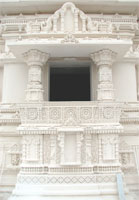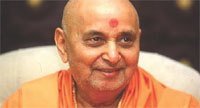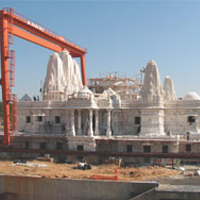Mandir: Celebrating Heritage and Nurturing the Future
 The 21st century brought with it technological advances with such power and precision that in the last fifty years, man has seen more technological development than he has seen in the last 5000 years But let us pause and ponder upon the words of one of this century’s most eminent scientists, Charles Steinmetz:”Someday people will learn that material things do not bring peace or happiness, and are little in making men and women creative and powerful.
The 21st century brought with it technological advances with such power and precision that in the last fifty years, man has seen more technological development than he has seen in the last 5000 years But let us pause and ponder upon the words of one of this century’s most eminent scientists, Charles Steinmetz:”Someday people will learn that material things do not bring peace or happiness, and are little in making men and women creative and powerful.
|
The following are key dates for inauguration festivities at the new Mandir in Lilburn, GA: |
|
August 16th – 30th, 2007 |
|
Friday, August 24, 2007 |
|
Saturday, August 25, 2007 |
|
Sunday, August 26, 2007 |
Today, man is plagued with the arduous task of balancing professional ambitions with their personal life, creating imperfect relationships and a demanding family life, leaving the average individual with an ardent craving for answers to one of life’s most pressing questions: “How can I attain peace of mind?”
A modern voice addressing this question, His Holiness Pramukh Swami Maharaj, asks, “If hospitals heal a broken heart, who will mend a broken soul? If schools will educate the mind, then who will educate the soul? Movies, clubs and restaurants will excite the mind senses, but where will one go for peace of mind?”
Many religions in their own traditions build houses of worship. Different traditions have different names for theses places: churches, derasar, gurudwars, synagogues, mosques, pagodas, and mandirs. Faith can be our greatest strength and places of worship fuel our faith in God, strengthen our communities and teach our families lessons for a peaceful life.
Mandir is the name for a Hindu place of worship and prayer. The word mandir is composed of two words, Man and Dir, whose meanings are mind and still, respectively. Therefore, a mandir is a place where the mind becomes still; a place where  we experience peace from worldly problems. For centuries, the mandir has remained a spiritual, educational, social and physical cornerstone of Indian society. People from all walks of life spend time growing, interacting, and learning in the mandir. In addition to being a home for Hindu manifestations of God, a mandir is also an active community space where many social service activities are carried out. Some mandirs serve not only a community’s spiritual needs, but also their physical needs such as providing relief for victims of natural disasters, providing medical care to the sick, education to the poor, numerous other services to help fellow mankind. It is with this to hope to further its philanthropy and spirituality that the BAPS Swaminarayan Sanstha constructs traditionally accurate mandirs in North America.
we experience peace from worldly problems. For centuries, the mandir has remained a spiritual, educational, social and physical cornerstone of Indian society. People from all walks of life spend time growing, interacting, and learning in the mandir. In addition to being a home for Hindu manifestations of God, a mandir is also an active community space where many social service activities are carried out. Some mandirs serve not only a community’s spiritual needs, but also their physical needs such as providing relief for victims of natural disasters, providing medical care to the sick, education to the poor, numerous other services to help fellow mankind. It is with this to hope to further its philanthropy and spirituality that the BAPS Swaminarayan Sanstha constructs traditionally accurate mandirs in North America.
In the early 1980’s a handful of Swaminarayan devotees in the Atlanta area began meeting at each other’s homes on a weekly basis to hold religious gatherings. As the number of devotees and the Indian community in the surrounding area steadily increased, a special place of worship was needed, and with the help of devotees from around the southeastern states, a skating rink was purchased in 1988. Even then, a large BAPS volunteer force completely transformed the old dilapidated rink into a mandir in Clarkston, GA.
Since 1988 the converted rink has served as a mandir and all that a mandir stands for. Over the years, however, it was evident that a traditional mandir was needed in Atlanta-one that would be able to help Hindus in America of all ages strengthen their roots. With this desire, and through the inspiration of Pramukh Swami Maharaj, a decision to build a traditional shikharbaddh (spired) mandir Atlanta was made.
With the blessings of Pramukh Swami Maharaj, in February of 2000, a twenty-nine acre plot of land at the intersection of Rockbridge Road and Lawrenceville Highway was purchased in Lilburn, GA, a quiet suburban town of Atlanta. A puja was also performed this same year by Pramukh Swami Maharaj to sanctify the land so that construction may begin. BAPS broke ground on the mandir project in September 2005, with land being cleared and ready for the main foundation pouring just four months later in January of 2006.
In March 2006 a crane was assembled just in time to install the first of what will be a monument with over 106,000 cubic feet of Italian Carrara. Over 15,000 pieces of hand-carved pieces have been shipped from India in what, by completion, will be 346 containers to Atlanta.
Sitting 72 feet high, 122 feet wide, and 227 feet long, the true spirit of seva, or selfless volunteering, continues to live on in this mandir just as it does in every BAPS project. Some two million man hours of labor will go into building this special house of worship, with high school and college students foregoing their summer vacations to sweat in the Atlanta summer heat to make this project a success. Along with the young, many professionals and business people, including both men and women, have temporarily put their lives on hold to ensure that the approximately 30,000 square foot mandir will be completed by the end of August.
BAPS mandirs are a rare and valuable gift to society that aim to imbibe cultural, moral and spiritual values To thousands of people who visit it daily to pray, celebrate, and receive inspiration.
Culture: The cultural roles that mandirs have played throughout history are still visible in today’s mandirs. Mandirs are the haven of cultural education and progress. BAPS mandirs preserve language, music and art by equally serving as teaching centers.
 Morality: Through engaging discourses, exhibitions, classes and activities, individuals at a mandir learn of values that will lead to a pious life. Bad habits, faults and addictions wane in the positive environment of the mandir. Children, youths and adults can freely build a balanced and morally sound life through specialized weekly assemblies which are regularly conducted at all BAPS Mandirs.
Morality: Through engaging discourses, exhibitions, classes and activities, individuals at a mandir learn of values that will lead to a pious life. Bad habits, faults and addictions wane in the positive environment of the mandir. Children, youths and adults can freely build a balanced and morally sound life through specialized weekly assemblies which are regularly conducted at all BAPS Mandirs.
Spirituality: Through its teachings and activities of prayer and worship, the mandir generates devout faith in God and alleviates mental and physical stress. Moreover, it is the home to Sadhus (ascetics), whose presence is crucial to the transmission of knowledge of Hinduism to the children, youths and adults. “This mandir will truly serve individuals, families and communities.
We welcome everyone to experience this unique monument. It will be a valuable addition to the great city of Atlanta and the surrounding communities,” said spokesperson Mitesh Patel Today, BAPS has over 650 mandirs worldwide. Inspired by Pramukh Swami Maharaj, the fifth spiritual successor of Lord Swaminarayan and present leader of BAPS, all of the mandirs are built with the gift of time and labor of hundreds of volunteers. At the age of eighty-seven, paying no attention to his health or schedule, Swamishri dedicates much of his time, planning, organizing, and overseeing every aspect of the mandir’s construction. He has a unique ability to mentally collate construction updates and make prompt suggestions and changes.
 Pramukh Swami stresses why mandirs are essential to humanity: “A mandir increases moral values. Mandir is such a place where everyone can have equal benefit. Peace of mind will be experienced here. Come to the mandir. Pray. Read. Chant. Sing. That is what it is for; to give peace. The mandir is our true home. The mandir is built for us to make our lives ideal!”
Pramukh Swami stresses why mandirs are essential to humanity: “A mandir increases moral values. Mandir is such a place where everyone can have equal benefit. Peace of mind will be experienced here. Come to the mandir. Pray. Read. Chant. Sing. That is what it is for; to give peace. The mandir is our true home. The mandir is built for us to make our lives ideal!”
With the blessings of Pramukh Swami Maharaj, in February of 2000, a twenty-nine acre plot of land at the intersection of Rockbridge Road and Lawrenceville Highway was purchased in Lilburn, GA, a quiet suburban town of Atlanta.


























